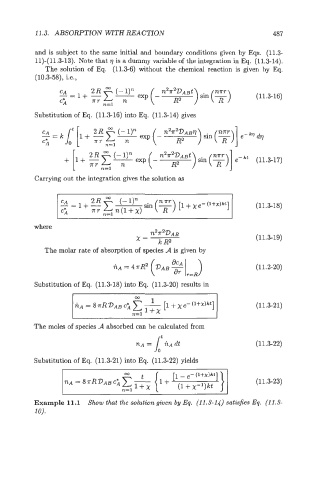Page 507 - Modelling in Transport Phenomena A Conceptual Approach
P. 507
11.3. ABSORPTION WITH REACTION 487
and is subject to the same initial and boundary conditions given by Eqs. (11.3-
11)-(11.3-13). Note that q is a dummy variable of the integration in Eq. (11.3-14).
The solution of Eq. (11.3-6) without the chemical reaction is given by Eq.
(10.3-58), Le.,
-=1+ -E- O0 (- '1" exp (- n2Tpt) sin ( - nz) (11.3-16)
CA
c*A TT n= 1 n
Substitution of Eq. (11.3-16) into Eq. (11.3-14) gives
-(F)] e-kt
+ ~ + ~ ~ ~ e n2TzBt) (11.3-17)
sin
p
(
x
Carrying out the integration gives the solution as
(11.3-18)
where
(1 13-19)
The molar rate of absorption of species A is given by
(1 1.2-20)
Substitution of Q. (11.3-18) into Eq. (11.3-20) results in
(1 1.3-21)
The moles of species A absorbed can be calculated from
t
nA = 1 nAdt (11 3-22)
Substitution of Eq. (11.3-21) into Eq. (11.3-22) yields
(11.3-23)
Example 11.1 Show that the solution given by Eq. (11.3-14) satisfies Eq. (11.3-
10).

